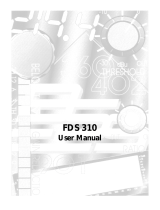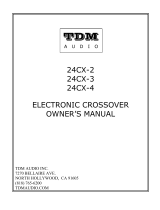Note: the High 1 and the Input 2 jacks are not used when configured for
three-way.
Front Panel
Power Switch
The power switch applies and removes power to the 310. Make sure all
equipment after the 310 is either off or the volumes are turned all the way
down before turning on or off the 310.
Clip Indicators
Separate High and Low clip indicators are provided for each frequency
band in the 310. These indicators will light at approximately 3dB before
clipping occurs in any stage of the 310. If these indicators light, you are
overloading the 310. Either turn down the input controls on the 310 or
turn down the output level of the piece of equipment in front of the 310
(i.e. mixer, equalizer or other piece of processing equipment.).
Input Level
An Input Level control is provided on each channel of the 310. If you are
using the 310 as a mono 3-way crossover, the Input control on the far left
is the only one used. The input level control should be set at its “0” mark-
ing in most cases. Adding or reducing gain should only be done to make
up for deficiencies in another part of the system.
Mute Switches
Mute switches are provided for each output on the 310. These are intend-
ed for use when setting up your system and testing either the crossover
frequency point or the separate cabinets (and amplifiers) they are feed-
ing. These switches allow you to isolate a specific frequency output on a
specific channel for fine-tuning or trouble-shooting. It is not recommended
that you mute or activate any frequency band during normal usage.
Levels should be turned down while the mute switches are either activat-
ed or de-activated.
High and Low Output Levels
Each channel of the 310 has a High and Low Output Level control. These
controls are used to set the output levels to the next piece of equipment
connected to the 310. (In most cases this would be power amplifiers.)
There is no gain associated with these controls - only attenuation. In most
cases you will use the 310 with the output controls set fully clockwise (at
their “0” setting.) If you find that you are overdriving the inputs of your
3
Stereo 2-Way and Mono 3-Way Operation
A stereo 2-way sound system is typically set up as follows: Separate
high frequency (horn or full range) and low frequency (bass or sub) cabi-
nets are used for each side (left and right) of the sound system. The
crossover is used to split each side of the stereo signal into two frequen-
cy bands which will feed separate power amplifiers. This arrangement
accomplishes two things: it allows the proper frequencies to be routed to
the proper speaker cabinets and it allows the amplifier to produce power
more efficiently to the speakers it is driving.
A 3-way sound system is typically set up as follows: Separate high
frequency (horn), mid frequency (mid or full range) and low frequency
(bass or sub) cabinets are used for each side (left and right) of the sound
system. The crossover is used to split each side of the stereo signal into
three frequency bands which will feed separate power amplifiers. This
arrangement accomplishes two things: it allows the proper frequencies to
be routed to the proper speaker cabinets and it allows the amplifier to
produce power more efficiently to the speakers it is driving.
You will need two 310 crossovers if you’re three-way system is stereo.
It is very important that you use caution when selecting the
crossover points for any system. Refer to the documentation that
came with your speaker cabinets for information on their proper fre-
quency ranges. This is especially important for high frequency
horns; damage may occur from sending lower frequencies than
specified into the drivers!
Rear Panel
Input and Output Connections
The XLR input and output connections are balanced and follow the AES
standard for wiring: Pin 1 = Ground, Pin 2 = Hot (+), Pin 3 = Cold (-). The
input and output 1/4” connectors are unbalanced. The 1/4” connections
are: Tip = Hot (+) and Ring = Cold (-).
The input and output jacks are labeled for stereo 2-way and mono 3-way
use. For stereo two-way usage, follow the connections labeled one (1)
and two (2). Example: Input 1, Low 1, High 1. For mono three-way usage,
follow the connections labeled Input, Low, Mid, High.
2









